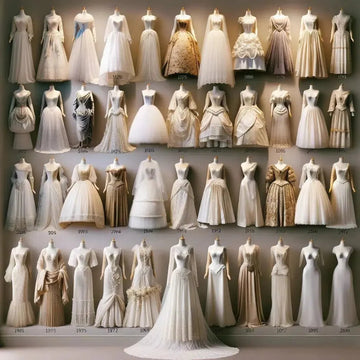
Wedding dresses have a rich and varied history, reflecting cultural changes, fashion trends, and personal expressions of love and commitment. From ancient times to the modern era, the evolution of wedding dresses is a fascinating journey that highlights the significance of this iconic garment. Let's explore the history of wedding dresses and how they have transformed over the centuries.
Ancient and Medieval Times
Early Civilisations: In ancient civilisations such as Egypt, Greece, and Rome, brides typically wore simple, flowing garments that symbolised purity and fertility. These early wedding dresses were often white or light-coloured to represent innocence and were adorned with flowers and simple jewellery.
Medieval Europe: During the medieval period, brides from wealthy families wore luxurious fabrics such as velvet, silk, and fur. The colour of the dress was less important than its richness and expense, symbolising the bride's family's social status. Blue was a popular colour as it symbolised purity and was associated with the Virgin Mary.
Renaissance to 18th Century
Renaissance Era: The Renaissance era saw the introduction of more elaborate and decorative wedding dresses. Brides wore gowns made of rich fabrics, with intricate embroidery, jewels, and fur trims. The dresses often featured long trains and voluminous sleeves, reflecting the fashion trends of the time.
17th and 18th Centuries: In the 17th and 18th centuries, wedding dresses became even more ornate, with heavy embellishments and detailed lacework. The concept of a "white wedding" dress had not yet become standard, and brides often wore their best dresses, regardless of colour. Silver and gold were popular choices for their opulence.
19th Century: The Birth of the White Wedding Dress
Queen Victoria's Influence: The tradition of the white wedding dress is often attributed to Queen Victoria, who wore a white gown for her marriage to Prince Albert in 1840. Her choice of a white dress, adorned with Honiton lace, set a trend that symbolized purity and became widely adopted.
Victorian Era: Following Queen Victoria's wedding, white became the dominant color for bridal gowns. Dresses were typically made with luxurious fabrics like silk and satin, and featured full skirts supported by crinolines and hoop skirts. The Victorian era also saw the introduction of elaborate veils and train lengths that varied based on the bride's social status.
20th Century: Changing Trends and Modern Influences
Early 20th Century: The early 20th century saw a continuation of the Victorian style with a few modifications. Dresses became simpler and more practical during World War I, reflecting the times' austerity. The 1920s introduced shorter hemlines and dropped waists, influenced by the flapper style.
Post-War Era: After World War II, wedding dresses returned to a more traditional style with full skirts and cinched waists, popularised by designers like Christian Dior. The 1950s and 1960s saw the influence of Hollywood, with glamorous and elegant designs.
Late 20th Century: The latter part of the 20th century brought diversity in wedding dress styles. The 1970s embraced bohemian and relaxed styles, while the 1980s saw extravagant designs with puffy sleeves and long trains, inspired by Princess Diana's iconic wedding dress.
21st Century: Modern and Personalised
Contemporary Trends: Today, brides have more choices than ever before. Modern wedding dresses come in various styles, from traditional ball gowns to sleek and minimalist designs. There is a growing trend towards personalisation, with brides choosing dresses that reflect their style and personality.
Sustainable and Eco-Friendly: In recent years, there has been a rise in sustainable and eco-friendly wedding dresses. Designers are using organic fabrics, recycled materials, and ethical production methods to create beautiful gowns that are environmentally conscious.
Conclusion
The history of wedding dresses is a testament to the changing fashions, cultural values, and personal expressions of brides throughout the ages. From ancient simplicity to modern elegance, wedding dresses have evolved to reflect the times while maintaining their significance as a symbol of love and commitment. At Divine Bridal, we honor this rich history by offering a wide range of styles that cater to every bride's unique taste. Visit our boutique to explore our latest collections and find your perfect wedding dress.



